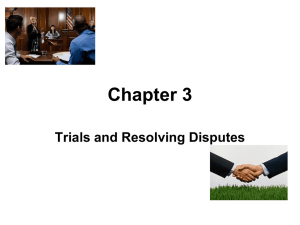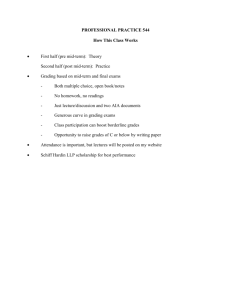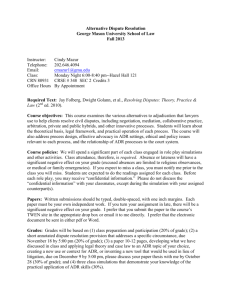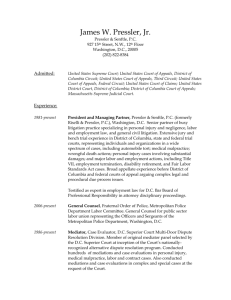File
advertisement
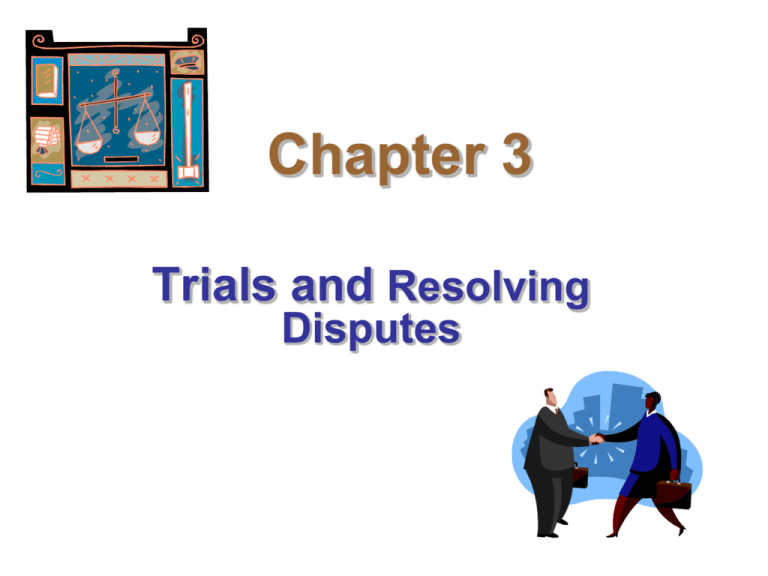
Chapter 3 Trials and Resolving Disputes Chapter Issues • Basic Trial Procedures • Procedures and Processes of Litigating a Dispute • Remedies in Civil Litigation • Appellate Stage • Alternative Dispute Resolution (ADR) – – – – Arbitration Negotiation-Settlement Mediation Other forms of ADR The Judicial System • The court system is adversarial( )الخصومةin nature • Parties have the responsibility for bringing a lawsuit()دعوى قضائية, shaping issues and presenting evidence()دليل • Lawyers represent the parties’ claims()المطالبات • Judges don’t investigate()بحث • Court applies legal rules( القواعد )القانونيةto facts presented • Trials are often costly and uncertain • Complex facts, extensive evidence()دليل, mountains of business records involved • Juries tend to be less sympathetic to businesses Basic Trial Procedures • • • • • • • Pleading Stage Discovery Stage Pretrial Stage Trial Stage Appellate Stage Enforcement Stage See Exhibit 3.2 The Pleadings Stage • Formal statements( )البيانات الرسميةmade to the court by the parties • Jurisdiction( )الوالية القضائيةneeded over subject matter & parties(jurisdiction – right and power to interpret law) • Notice of lawsuit( )دعوى قضائيةgiven by service of process by summons ()استدعاءات • Complaint()الشكاوى – Alleges( )يدعيfacts for jurisdiction & remedy/remedies – Requests remedy(ies) – See Exhibit 3.1 (Casino owner pokes a hole in a Picasso, and sues Lloyds of London for compensation for losses under his insurance policy with them.) • Responses to Complaint – Motion to Dismiss • By defendant – Answer (may include affirmative defenses) – Counterclaim Discovery Stage (Legal Tools to Obtain Evidence) • Rules of Civil Procedure set guidelines & limits to the process • Purposes to 1) preserve( )الحفاظ علىevidence()دليل, 2) limit element of surprise, 3) encourage settlement • Depositions of parties and witnesses (including experts) • Interrogatories( )االستجواباتof the parties()األطراف • Use of Expert Witnesses()شهود • Requests ( )طلبfor Admissions()القبول • Orders of Production of Documents • Physical( ..)فتاه/Mental( )فتاهExaminations • Impacts on business--expensive & time-consuming • See Cooper Tire & Rubber v. Mendez Cooper Tire and Rubber v. Mendez • • • • • • • • • • • Mendez was driving a minivan – 6 passengers Rear tire, made by Cooper Tire, lost its tread. Minivan rolled over. 4 passengers were killed. Mendez and 2 other survived. Examination showed nail had punctured the tire. Mendez and others sued Cooper for product defect. Jury awarded over $11 million damages. Appeals court affirmed. Cooper appealed that expert testimony of Richard Grogan, on behalf of Mendez, was inadmissible. HELD: Grogan’s presentation of a theory of wax contamination at manufacturing as a reason for the separation of the belts on the tire is unreliable and should not be admitted. Expert testimony is admissible if (1) the expert is qualified and (2) the testimony is relevant and based on a reliable foundation. Grogan is not a chemist, engineer or tire designer. Has a British national certificate equivalent to a high school diploma. No post-secondary degrees. Not accident reconstruction expert. (CONTINUED…) Cooper Tire and Rubber v. Mendez, cont. Grogan did work at Dunlop Tire Company in England, examining tires, including those that had failed. He teaches courses on tire failures and published a book entitled An Investigator’s Guide to Tire Failures, along with articles on tire failures. Grogan’s theory of wax contamination at manufacturing (creating separation of tire belt or tread) is supported only by his book and theory has not achieved general acceptance. Cooper’s chemical engineer Herzlich and other Cooper experts (one a chemist and former tire compounder; the other a chief chemist at the plant where the tire was manufactured) testified that wax migration is a normal, expected and understood phenomenon occurring during manufacture and the life of the tire. Cooper’s experts testified: Wax migration does not = a defect Grogan’s novel theory, that is not supported by science, does not meet the reliability standard for admission of expert testimony. Grogan’s testimony is not evidence of a defect and tire failure. REVERSED. Judgment rendered in favor of Cooper tire. Pretrial Stage • Summary Judgment—either party may request • Pretrial Conference—either party may request – – – – – – Usually attorneys and judge attend Simplify issues Plan course of the trial Judges get parties to drop certain parts of case Helps to focus on key issues Judges’ often encourage parties to reach out-ofcourt settlement Jury Selection • 6th and 7th Amendments gives right to a jury( )فتاهin certain cases • If no use of jury, judge becomes trier of fact • Selection of jury involves voir dire • Attorneys ( )فتاهallowed limited number of challenges to reject prospective jurors without stating reason • Usually 12 persons on jury panel • Some states have fewer—such as 6 jurors Trial Stage • • • • • Opening Statements by attorneys(lawyers) Presentation of Direct Testimony()شهادة Closing arguments()المرافعات الختامية Instructions to Jury (also called charges) Verdict by jury. Judgment may be set aside for jury misconduct. • Motions For A Verdict()حكم – Motion For A Directed Verdict/Motion For Judgment As A Matter of Law • Cases have been presented, but before going to jury, either party requests entering judgment in its favor – Motion for Judgment As A Matter of Law/Motion For Judgment Notwithstanding the Verdict (N.O.V.) Remedies in Civil Litigation (See Exhibit 3.4) • Monetary damages – Compensatory – Punitive or exemplary – Nominal • Equitable remedies – Specific performance – Injunction • Permanent • Temporary Appellate Stage (Appeal Based on Error of Law) • Arguments before the court – Written Briefs – Oral Arguments • Decisions by the court – Majority opinion – Concurring opinions – Dissenting opinions • Outcomes of decisions – Affirmed (declare positively )()وأكد – Modified – Reversed – Remanded()حبسه Enforcement Stage • If no further appeal is available, judgment becomes final • It is res judicata • Enforcement of judgment is through writ of execution • Court orders an official (i.e. sheriff) to satisfy judgment through an act (such as seizure of property, garnishment, etc.) • A complexity that causes parties to look for alternative dispute resolution ARBITRATION()تحكيم • • • • • • • • • Most widely recognized form of ADR Usually results are faster in resolution of matters()تسوية المسائل 3rd neutral party or panel (usually expert) is arbitrator or arbiter Parties agree upon this ADR in the contract or during a later dispute Arbitrator’s decision is binding Arbitration decision is final and matter usually cannot be litigated again or appealed Usual rule: No right to go to trial (parties to the dispute give up this right) – Appeals are very specific and limited Thousands of international disputes go to arbitration each year Uniform Arbitration Act (UAA) upholds the integrity of this process The Arbitration Process • • • • Decided at time of making the contract or after dispute arises Begins when party files a submission Parties agree on arbitrator(s) The hearing procedure – Closed door – Less restrictive procedural and evidentiary rules than a trial court – Arbitration associations have rules that guide participants/arbitrators • Good faith cooperation • Voluntary and prompt exchange of documents • Uncooperative parties may be required to pay fees and compensation by arbitrator The Arbitration Process . . . • The award (decision) – Usually given in writing within 30 days of close of arbitration hearing – Arbitrators have broad powers to decide remedies • Appealing the award – Attacks on arbitrators are rarely successful – Errors of fact or law are not reviewable – Grounds for overturning appeal: fraud, partiality, serious procedural misconduct, excessive use of power by arbitrator – Arbitrators have wide latitude in awards • Generally arbitration award is final Voluntary and Compulsory Arbitration • Labor Contracts – Unions – Insurance contracts – Stockbrokers – Pro-baseball, football • Public Sector Employment – Police officers – Firefighters – Public school teachers • See “Global Acceptance of Arbitration” • See also Cyberlaw: “International Arbitration and Mediation of Domain Name Disputes” “Global Acceptance of Arbitration” • Over 100 nations have signed the UN Convention on the Recognition & Enforcement of Foreign Arbitral Awards • In some countries, however, it’s harder to receive enforcement – China and India traditionally have had reputations for nonenforcement, although recent court decisions are moving toward enforcement Cyberlaw: “International Arbitration and Mediation of Domain Name Disputes” • World Intellectual Property Organization (WIPO) in Geneva establishes international rules for trademarks and other I.P. • WIPO has domain name resolution service to protect domains (i.e. .mx for Mexico and .edu for education) • WIPO has a Uniform Domain Name Dispute Resolution Policy (UDRP) dealing with such problems as “cybersquatting” • Parties go to Arbitration and Mediation Center (http://arbiter.wipo.int) where experts handle disputes • Fees are assessed – If 1-5 names included in a complaint--$1500 – If 3 panelists are requested -- $3000 • Over 1000 disputes/year submitted to the Center Negotiation • Least formal form of ADR • Parties decide to settle matter between themselves • Often use lawyers or representatives, though not required – Lawyers, etc. are agents of the parties of the dispute • Negotiated settlement is usually a contract, which is enforceable, like other contracts, by the courts Stages of Negotiation • Stage 1: Study issues and information • Stage 2: Exchange information – Different styles: i.e.“tough guy” vs. “problem solver” • Stage 3: Work your strategy – Usually means compromise • Stage 4: Agreement is reached; usually a contract is written • Policy of the courts is to enforce negotiated settlements as most are contracts. Mediation • 3rd neutral person (mediator) assists the parties of the dispute • Parties mutually decide on a resolution • Mediator makes suggestions • Mediator’s suggestions are NOT BINDING on the parties • Parties may go to trial after this ADR • Mediation often helps to maintain the relationship between the parties The Mediator • Some states have no requirements at law, but most states are moving toward some licensing • Most people prefer a trained or experienced person • If no requirements, the mediator may be the choice of the parties • If mediator fails to act professionally, may be subject to liability to one of the parties The Mediation Process • Mediator collects information, outlines key issues, listens, asks questions, observes the parties, discusses options, and encourages compromise • Mediator often helps to draft the settlement agreement • The settlement agreement is enforceable in court • Mediator may assist in deciding the confidentiality of the case • If confidentiality is agreed upon, nothing can be said in public • Information revealed during negotiation or mediation not to be used as evidence if the dispute goes to a later trial Creative Business Use of Mediation Example of Ford Motor Company • Ford is an example of efforts that try to avoid “bad press” through mediation • First consumers discuss complaint with dealer & local district office • If no resolution, complaint is next filed with Ford Consumer Appeals Boards • Board’s decision: binding on Ford but not consumers, who can still seek legal remedies • Process encourages dealer responsiveness to consumer problems Innovative Forms of ADR • Alternative Dispute Resolution Act of 1998 directs federal courts to implement a dispute resolution program, though Congress has not funded the mandate • Judges usually press for parties to negotiate a settlement • Many courts have formal mediation or other ADR Programs to resolve disputes • Summary Jury Trial: The jury equivalent of a minitrial – Advisory jurors are used; witnesses rarely used – Judgment is not binding (though jurors don’t know this) – Judge then meets with the parties to discuss decision and encourage settlement. – Dissatisfied parties may still take the case to court. – Nothing learned in this trial can be used as evidence in later full court proceedings. – Courts have held that ADR proceedings are closed to the public and the press. Expanding the Use of ADR (Congressional Encouragement) • Congress encouraged use of ADR originally in the Federal Arbitration Act • Congress has enacted more recently statues to encourage ADR – The Judicial Improvements Act – The Administrative Dispute Resolution Act • States have been changing their rules of civil procedure to encourage use of ADR techniques • The purpose is to reduce costs and delays associated with court systems
